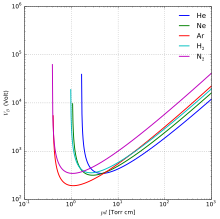
Paschen's law is an equation that gives the breakdown voltage, that is, the voltage necessary to start a discharge or electric arc, between two electrodes in a gas as a function of pressure and gap length.[2][3] It is named after Friedrich Paschen who discovered it empirically in 1889.[4]
Paschen studied the breakdown voltage of various gases between parallel metal plates as the gas pressure and gap distance were varied:
- With a constant gap length, the voltage necessary to arc across the gap decreased as the pressure was reduced and then increased gradually, exceeding its original value.
- With a constant pressure, the voltage needed to cause an arc reduced as the gap size was reduced but only to a point. As the gap was reduced further, the voltage required to cause an arc began to rise and again exceeded its original value.
For a given gas, the voltage is a function only of the product of the pressure and gap length.[2][3] The curve he found of voltage versus the pressure-gap length product (right) is called Paschen's curve. He found an equation that fit these curves, which is now called Paschen's law.[3]
At higher pressures and gap lengths, the breakdown voltage is approximately proportional to the product of pressure and gap length, and the term Paschen's law is sometimes used to refer to this simpler relation.[5] However, this is only roughly true, over a limited range of the curve.
- ^ Cite error: The named reference
Lieberman2005was invoked but never defined (see the help page). - ^ a b "Paschen's Law". Merriam-Webster Online Dictionary. Merriam-Webster, Inc. 2013. Retrieved June 9, 2017.
- ^ a b c Wadhwa, C.L. (2007). High Voltage Engineering (2nd ed.). New Age International. pp. 10–12. ISBN 978-8122418590.
- ^ Cite error: The named reference
:0was invoked but never defined (see the help page). - ^ Graf, Rudolf F. (1999). Modern Dictionary of Electronics (7th ed.). Newnes. p. 542. ISBN 978-0750698665.